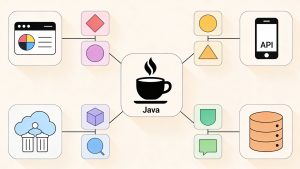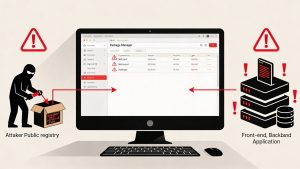Artificial Intelligence (AI) has revolutionized numerous industries, and software quality assurance is no exception. Organizations are increasingly recognizing the importance of integrating AI into their systems to enhance efficiency, accuracy, and overall quality in the Software Development Lifecycle (SDLC).
How AI is Transforming the Software Development Lifecycle
AI is proving to be a game-changer in the SDLC. As businesses strive to deliver higher quality software faster and more efficiently, AI-driven tools are becoming indispensable. In 2023, the market for generative AI in the software development lifecycle was estimated at USD 268.10 million globally, underscoring the growing investment in AI-driven development tools.
The potential of AI extends beyond simply improving speed and reducing manual errors. It fundamentally shifts how companies approach software development. AI-driven tools can automate repetitive tasks such as code review, testing, and bug fixing. This frees up valuable time for developers to focus on more complex and creative aspects of the project.
Moreover, with AI-powered predictive analytics, teams can identify potential bottlenecks early in the process. This enables proactive problem-solving and better resource allocation. By incorporating AI into the SDLC, organizations can make more data-driven decisions. AI tools analyze massive volumes of data, from user behavior patterns to historical code performance, providing actionable insights to refine development strategies. This allows companies to tailor their software solutions to real-time needs and user preferences, ensuring a more personalized product while keeping development costs in check.
AI-Powered Software Testing: Faster, Smarter, and More Efficient
AI significantly accelerates the testing phase by generating more robust and diverse test cases, including edge cases that human testers might miss. Automated testing powered by AI increases test coverage and reduces human error, leading to faster releases without sacrificing quality. This results in a shorter time to market for new features and updates, enabling businesses to remain competitive and adaptable.
Industry data suggests that AI adoption in software development could reach 90% within the next two years, driven by the tangible benefits AI brings to various stages of software development.
Integrating AI into the SDLC translates into tangible business benefits, such as higher productivity and improved product quality. AI enables businesses to innovate faster and respond to market shifts with agility, which is crucial in an environment where change is constant and competition is fierce.
The companies that embrace AI-driven development today are positioning themselves to lead tomorrow, whether in software delivery, customer experience, or revenue growth.
Top 10 AI Tools Transforming Software Quality Assurance
Here are ten of the top AI tools that are transforming software quality assurance:
Testim:
Testim utilizes AI to automate self-healing tests, which automatically adjust when there are changes to the code. This reduces the time and effort spent maintaining tests. Testim integrates smoothly with CI/CD pipelines, enabling teams to automate tests without disruption.
Keploy:
Keploy is designed to simplify and enhance test automation. It automatically generates test cases by analyzing application data and offers mock server capabilities for API testing. Keploy also helps identify flaky tests, ensuring the test suite remains reliable.
Applitools:
Applitools leverages AI for visual testing, helping detect UI discrepancies that can be hard to spot manually. It supports cross-browser and cross-device testing, ensuring applications look great on any platform.
Mabl:
Mabl combines AI and machine learning to create automated tests quickly and efficiently. It provides insights into performance and visual regressions, helping teams identify issues early. The low-code interface makes it accessible for users with varying technical expertise.
Test.ai:
Test.ai focuses on mobile and web app testing, using AI to automatically identify and test app features. It adapts to changes in the app without requiring constant updates to test scripts, reducing maintenance overhead.
Functionize:
Functionize uses natural language processing to enable QA teams to create tests in plain English. The AI-driven test execution speeds up the process and provides fast results. Being cloud-based, Functionize scales effortlessly as testing needs grow.
SmartBear (TestComplete):
SmartBear’s TestComplete is a versatile automation platform that supports multiple scripting languages and testing frameworks. AI-powered object recognition ensures that tests remain stable even as the UI changes. TestComplete integrates seamlessly with CI/CD tools like Jenkins and Azure DevOps.
Ranorex:
Ranorex offers a robust solution for automating testing across various platforms. The AI-enhanced object recognition ensures that even dynamic UIs are tested effectively, including mobile, web, and desktop applications. It also provides detailed reporting and test management tools.
Perfecto:
Perfecto offers cloud-based testing for mobile and web apps, ensuring tests are scalable and flexible. The AI-powered error analysis quickly identifies the root causes of issues, saving debugging time. Perfecto supports testing on real devices, crucial for ensuring accurate results.
Selenium with AI Add-Ons:
Selenium, a widely used automation tool, can be enhanced with AI-driven plugins that improve element recognition and dynamic UI handling. Integrating these AI add-ons makes existing Selenium test suites more robust and adaptive.
The Future of Software Testing: How AI is Shaping Quality Assurance
AI has become a game-changer in software testing and test automation. By harnessing AI, companies can significantly reduce manual testing efforts, develop better products and software, improve accuracy, and accelerate release cycles. Tools like Testim, Applitools, and Keploy exemplify how AI can be leveraged to make testing smarter.
AI-driven testing solutions help streamline processes, reduce errors, and deliver higher-quality software faster. Whether you’re a developer, QA engineer, or part of a larger team, these transitions can greatly benefit you.
As these tools continue to evolve, they will become more accessible and more powerful. Teams of all sizes can work more efficiently and stay ahead of the competition by using them. The future of test automation is AI, and it’s time to explore how these tools can transform testing workflows and set you on the path to success.
FAQs
How does AI improve the software development lifecycle (SDLC)?
AI enhances the SDLC by automating repetitive tasks like code reviews, bug detection, and test generation. It also provides predictive analytics to identify bottlenecks early, leading to faster development, improved efficiency, and reduced errors.
What are the key benefits of using AI-driven test automation tools?
AI-driven test automation tools offer benefits such as self-healing tests, enhanced test coverage, reduced maintenance efforts, quicker bug identification, and overall faster release cycles. These tools ensure more reliable and high-quality software.
Why is AI important in software testing?
AI helps software testing by generating comprehensive test cases, identifying UI discrepancies, automating repetitive tests, and predicting potential issues before they arise. This improves accuracy and efficiency while reducing manual effort.
What are some of the best AI-powered test automation tools?
Some of the top AI-powered test automation tools include Testim, Keploy, Applitools, Mabl, Test.ai, Functionize, SmartBear TestComplete, Ranorex, Perfecto, and Selenium with AI add-ons. Each tool offers unique features to enhance testing efficiency.
How can companies get started with AI in software testing?
Companies can start by identifying repetitive testing tasks that AI can automate, selecting AI-driven test automation tools suited to their needs, integrating them into their CI/CD pipelines, and training teams to leverage AI insights for better decision-making.
Read more such articles from our Newsletter here.



